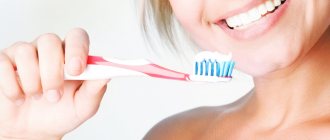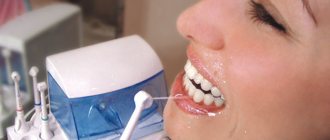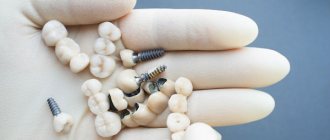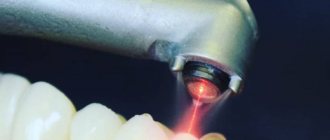Braces
Braces are micro locks that are fixed to the surface of the teeth with glue. A ligature is threaded through them. The orthodontist pulls functional elements through the holes in the locks, thereby creating efforts to align the teeth in the desired direction. Today, the variety of braces systems is literally amazing.
Braces can be:
- Ligature and non-ligature.
- Vestibular and lingual. The first are attached to the front surface of the teeth, the second - to the lingual, and are completely invisible to others. Lingual systems are more expensive and take longer to get used to.
- Made from a variety of materials - metal, ceramics, the inclusion of precious artificial sapphires, and so on.
The idea that only teenagers wear braces is long gone. Adults, wealthy and accomplished people readily turn to an orthodontist if they are not satisfied with the appearance of their teeth.
Laminates for teeth
Straight overlays are called "laminates". They are made from a composite light-curing material in the patient's mouth. Before installing the laminate, the tooth is prepared and ground. In this case, its surface is covered with several layers of composite. If the patient does not want the top enamel layer to be removed from the surface of his tooth, then the doctor uses opaque shades of the composite material, which are called “opaque.” However, the use of such a composite can create the effect of false nails, which is noticeable to a prying eye. The fact is that the teeth will turn out to be bulging, unaesthetic and unnatural. The service life of laminates depends on the quality of oral hygiene and the degree of chewing load. The patient's addiction to alcoholic beverages significantly reduces the strength of composite veneers. Porcelain veneers are stronger, more durable, and more durable. They are made in laboratory conditions and are famous for their amazing aesthetics, stability of shade and configuration, as well as long service life.
What to choose: braces or veneers
Let's summarize:
- If the defect is minor, it can be corrected using a ceramic onlay by grinding off the protruding or unfolded part of the tooth. If there is severe pathology, veneers are not used.
- If the patient, in addition to problems with bite, also has other complaints about his own teeth, such as uneven color, insufficient whiteness, teeth that are too small or crooked, it is important to understand that braces will not solve these problems. Only by covering your teeth with ceramic onlays can you achieve satisfactory aesthetics.
- You don't have to get used to veneers. Braces will require 1-2 weeks of getting used to. It may seem to you that the design interferes with normal diction and rubs soft tissues. If the discomfort is too significant, you should contact an orthodontist so that he can correct the installed system.
- Wearing braces requires regular visits to the doctor. And not just preventative – once every six months, but every month – to adjust the ligature.
A doctor you trust will help you make the right choice between dental onlays and corrective braces.
Author:
Mayorov Andrey Mikhailovich
Specialization:
orthopedic dentistry, dental prosthetics, implant installation
Veneers
As we wrote above, braces and veneers solve different problems and it is not entirely correct to compare them, but braces and veneers can also make a smile more aesthetically pleasing. The choice depends on the initial situation and the desired result.
Braces will make the dentition straight, correct protruding (dystopic) teeth, tilted teeth, but are not able to change their color, shape, or size. Veneers will help with slight unevenness and close tooth gaps - by preparing the tooth and installing an onlay of the desired shape.
| Braces | Veneers | |
| Braces | Veneers | |
| The main task | Correction of teeth position (bite) | Correction of teeth shape and size |
| Preparation stages | Diagnostics, sanitation, professional oral hygiene. | Diagnostics, sanitation, professional oral hygiene, mock-up preparation, fitting, tooth preparation. |
| Correcting teeth color | No | Yes |
| Repairing chips and cracks | No | Yes |
| Correction of uneven teeth, crowding | Yes | only minor bumps |
| Closing teeth and diastemas (gaps between teeth) | Yes | No |
| Closing a gap from a missing tooth | yes, due to the movement of adjacent teeth | yes, by installing a crown or bridge. |
| Cost (average, based on the price list of the Confidence clinic) | 200,000₽ (for installation of braces and orthodontic treatment) | 200,000₽ (for installation of 6 units of ceramic veneers) |
| Preparation time for installation | from 2 weeks | from 4 weeks |
| Terms of wearing | 1.5-2 years | 10 years or more with proper care |
Price
Braces
Turnkey braces for both jaws cost:
- metal ones - from 20 thousand, the simplest ones, the price can reach up to 100-150 thousand;
- ceramic with metal grooves - from 50 thousand;
- all-ceramic - from 130 thousand;
- sapphire - from 150 thousand;
- lingual - from 200 thousand.
Children in public clinics receive metal braces free of charge.
Veneers
The cost of one veneer starts from 15 thousand rubles. Their thinner analogues, ultraneers and lumineers, already cost 40–50 thousand apiece. You need to put at least 6, and preferably 8 veneers on one jaw. So the minimum cost of installing veneers will be approximately 180 thousand rubles.
Veneers, and especially their thinner counterparts, are more expensive than braces.
Indications for installation
Before making a final decision, it is necessary to understand what each of these orthodontic structures is.
Indeed, contrary to popular belief, they are not interchangeable, and the commonality of indications is relatively relative.
When are veneers needed?
Veneers are special plates attached to the front of the tooth. With their help, it is possible to eliminate cosmetic defects in the smile area without direct correction of the dentition.
Teeth straightening without braces using veneers is indicated for the following defects:
- hiding gaps between teeth;
- correction of minor curvature;
- enamel whitening, correction of defects (chips, stains);
- visual lengthening of a short tooth and change in the shape of the crown.
When preparing veneers, various materials can be used. Each patient has the right to choose the most suitable option in terms of price/quality ratio:
- Veneers made of composite compounds. The only advantage of composite veneers is their relatively low cost. They are less durable, not as aesthetically pleasing and tend to darken over time, like a regular filling.
- Ceramic veneers. These dental structures are ideally matched to the natural color of the tooth, are highly durable and do not change their shade even after 10 years.
Depending on the degree of translucency of the patient's enamel, porcelain veneers can be made from porcelain or silica.
Inability to install
Unlike braces, wearing veneers does not cause discomfort to the patient. However, in some situations it is not possible to install overlay plates:
- extreme sports (expensive treatment will be short-lived);
- bruxism;
- thin walls of the tooth, the presence of large fillings on the inner surface, significant tissue destruction;
- malocclusion;
- the presence of bad habits in which fragile plates will constantly be in contact with hard material (for example, the habit of biting nails);
- absence of chewing teeth (sixes and sevens) in a row.
Installation of veneers is also possible after removal of braces, when, in the absence of proper oral care, the structure of the enamel has been damaged or its color has changed.
Braces - indications and advantages
Braces are special dental structures that straighten teeth using constant pressure on them in a certain direction.
With their help, you can correct numerous dental anomalies in children and adults. The duration of treatment is 1-3 years depending on the degree of curvature. Wearing braces is indicated in the following cases:
- malocclusion, dental anomalies;
- abnormal development of individual teeth, their projection into a common arch;
- as a preparatory stage for prosthetics;
- aesthetic correction of the facial profile.
Depending on the type of construction, there are two main types - lingual braces and vestibular braces.
The main advantage of the first option is the hidden location of the system on the inside of the tooth. This, in fact, is their only advantage over classic braces.
The bracket design can be made of various materials:
- metal is not the most attractive option in terms of aesthetics, but it is the most effective even in advanced cases;
- ceramics - a less effective and durable design, but very comfortable for patients who pay special attention to their appearance;
- artificial sapphire is an ideal option in all respects, but the pleasure is not cheap;
- plastic - the only advantage is the price.
Categorical prohibitions
Despite the obvious advantage of braces over other methods of orthodontic treatment, there are strict contraindications to installing a corrective system:
- damage to tooth enamel;
- caries;
- numerous fillings and implants;
- regularly consuming foods and drinks high in sugar;
- mental illnesses;
- severe chronic diseases of internal organs;
- allergic reaction to materials.
Most of these contraindications are not absolute. Therefore, after treatment and elimination of risk factors, you can return to the issue of installing braces.
The same can be said about the presence of implants and filled teeth. This complicates the dentist's task somewhat and may require repeated dental intervention in the process of correcting the bite. But, in general, it is possible to find a way out of the situation.
Additional doctor visits and procedures
| Additional doctor visits and procedures | ALINERS | BRACKETS | VENEERS |
| Frequency of doctor visits | Once every 4-6 weeks | every 2 weeks | after fixation once 6 months |
| Probability of root canal treatment | low | low | high |
You should most rarely visit a doctor after installing veneers, most often - every two weeks - when installing braces. Aligners are a relatively comfortable visit once every month to a month and a half.
- Until what age can you get braces?
- Is it possible to put braces on implants, crowns and filled teeth?
- Is it possible to wear braces with implants?
- When can children get braces?
Possible complications
Braces
Braces can cause the following complications:
- Pain and discomfort immediately after braces are installed.
- Damage and inflammation of the mucous membrane due to injury from protruding parts of the structure.
- Plaque and tartar due to insufficient cleaning. May lead to gum inflammation.
- Caries due to insufficient cleaning.
- Stains on the enamel after removing braces. They appear if the braces were not glued tightly enough and plaque got under them.
- Increased sensitivity of teeth after removal of the structure.
All these complications can be avoided if you visit the dentist with any problems and brush your teeth thoroughly.
Veneers
Usually there are no problems after installing veneers. To install them, you need to grind down the enamel, so the teeth may ache a little for the first couple of days, but this goes away quickly. There are no other complications.
Veneers are not only more comfortable to wear, but also safer, since there are no problems with them.
- Braces or veneers: the best way to straighten teeth
- Is it possible to install veneers immediately after removing braces?
- Which braces are better, ceramic or metal?
- What braces are best for a teenager? Price and reviews
Features of teeth straightening with braces
This design is most often used to straighten teeth.
The use of braces has a number of features, which are as follows:
- Wearing pull rods is required along with braces. These are special rubber bands that allow you to correct your bite. They are worn constantly and should only be removed at night. Some people find it difficult to tolerate wearing intermaxillary cords;
- Duration of treatment. For correction, braces should be worn for at least one year, the specific period is determined depending on the complexity of the pathology;
- Once the braces are removed, the treatment does not end. In order to consolidate the results, you must wear retainers. This will allow the teeth to get used to and remain in their new correct position. The duration of wearing is at least six months.











